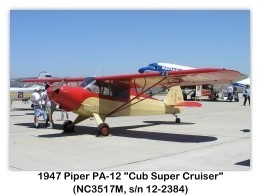

























Piper PA-12 Super Cruiser
Single-engine three-seat high-wing monoplane
Archive Photos 1
Piper PA-12 Super Cruiser (N92547, c/n 12-76, 1946) on display c.1990 at the MCAS El Toro Airshow, MCAS El Toro, California (Photos by John Shupek)

Piper PA-12 Super Cruiser (NC3517M, c/n 12-2384, 1947) on display c.2006 at the Camarillo Air Show, Camarillo, California (Photos by John Shupek)

Overview 2
Piper PA-12 Super Cruiser
- Role: Personal use aircraft
- National origin: United States
- Manufacturer: Piper Aircraft
- Primary user: private owners
- Unit cost: US$2,995
- Developed from: Piper J-5
- Variants: Piper PA-14
The Piper PA-12 Super Cruiser is an American three-seat, high wing, single engine conventional landing gear-equipped light aircraft that was produced by Piper Aircraft between 1946-48. The PA-12 was an upgraded and redesignated Piper J-5.
Development 2
When Piper dropped the J- designation system in exchange for the PA- system, the J-5C became the PA-12 Super Cruiser. The earlier J-5s had been powered by either a 100 hp (75 kW) Lycoming O-235 or a 75 hp (56 kW) Lycoming O-145. The newer PA-12 model was initially powered by a 108 hp (81 kW) Lycoming O-235-C engine, was fully cowled, and had a metal spar wing with two 19 gallon fuel tanks. A Lycoming O-235-C1 engine rated at 115 hp (86 kW) for take-off was optional.
The PA-12 is approved for wheels, skis, floats and also for crop spraying. The PA-12 cockpit accommodation is provided for the pilot in the front seat and two passengers in the rear seat, side-by-side. Unlike the J-3 Cub the PA-12 is flown solo from the front seat.
Operational Use2
Many Piper PA-12 Super Cruisers have been modified with larger engines. Wing flaps and a metal-skin fuselage can be added as modifications.
In 1947, two Piper PA-12 Super Cruisers named City of Washington and City of Angels flew around the world, and the worst mechanical failure they suffered was a cracked tailwheel. The City of Washington currently resides at the Boeing Aviation Hangar, part of the Steven F. Udvar-Hazy Center in Chantilly, VA. The City of Angels is on display at the Piper Aviation Museum in Lock Haven, PA.
Many Piper PA-12 Super Cruisers are still flown and the type is commonly seen in North America. In November 2009 there were still 1688 registered in the USA and 229 in Canada.
Variants2
- PA-12: Original model type certified 24 March 1947, with a gross weight of 1,750 lb (794 kg) in the Normal Category and 1,500 lb (680 kg) in the Utility Category.
- PA-12S: Second model type certified 11 August 1948, with 1,838 lb (834 kg) gross weight, Normal Category only.
Specifications (PA-12 Super Cruiser) 3
Type
- Three-seat light cabin monoplane.
Wings
- High-wing braced monoplane
- Wings attached direct to build-in center-section on top of the fuselage and braced to the lower longerons by steel-tube Vee struts.
- Wing structure consists of Spruce spars and aluminum-alloy ribs, the whole being covered with fabric Frise-type ailerons operated by cables.
- No flaps.
Fuselage
- Rectangular structure of welded steel tubes, with fabric covering.
Tail Unit
- Braced monoplane type.
- Welded steel-tube framework covered with fabric.
- Self-aligning streamline wire bracing.
- Elevator Adjustable in-flight.
Landing Gear
- Fixed a divided type.
- Two-side vees and has-axles hinged to cabane within fuselage.
- Rubber cord shock-absorption.
- Hayes wheels 841 (8.00 × 4 tires).
- Hydraulic expander tube brakes.
- Three leaf-spring full-swiveling tailwheel.
- Alternatively, twin-float or ski undercarriage.
Power Plant
- One Lycoming O-235-C four-cylinder horizontally-opposed air-cooled engine enclosed in hinged pressure cowling, and developing 104 hp at 2,600 rpm.
- Sensenich two-blade fixed-pitch wooden airscrew.
- Fuel capacity 38 US gallons (143 liters)
- Oil capacity to US gallons (7.5 liters)
Accommodation
- Enclosed cabin seating pilot forward and two passengers side-by-side in rear seat.
- Dual controls, rear set removable.
- Access door on starboard.
- Baggage compartment aft of rear seat.
Dimensions
- Wing span: 35 ft 5½ in (10.80 m)
- Wing chord: 5 ft 3 in (1.6 m)
- Length: 22 ft 10 in (6.96 m)
- Height: 6 ft 10 in (2.08 m)
- Wheel track: 6 ft 2½ in (1.89 m)
- Propeller diameter: 6 ft 2 in (1.88 m)
- Baggage compartment: 13 × 12 × 30 in (33 × 30.5 × 76 cm)
Areas
- Wing area, gross: 179.3 ft² (16.65 m²)
- Fin area: 4.7 ft² (0.43 m²)
- Rudder area: 6.8 ft² (0.63 m²)
- Tailplane area: 15.10 ft² (1.4 m²)
- Elevator area (total): 11.7 ft² (1.08 m²)
Weights
- Weight empty: 950 lb (431 kg)
- Useful load: 800 lb (363 kg)
- Weight loaded: 1,750 lb (793 kg)
- Baggage allowance: 41 lb (18.6 kg)
Loadings
- Wing loading (fully loaded): 9.76 lb/ft² (47.65 kg/m²)
- Power loading: 16.82 lb/hp (7.63 kg/hp)
Performance
- Maximum speed at sea level: 115 mph (185 km/h)
- Cruising speed: 105 mph (168 km/h)
- Landing speed: 49 mph (78.4 km/h)
- Climb: 510 ft/m (155 m/m)
- Absolute ceiling: 15,500 ft (4,725 m)
- Absolute ceiling at 1,500 lb: 18,000 ft (5,490 m)
- Cruising range: 600 miles (965 km).
- Take-off run: 640 ft (195 m)
- Take-off run at 1,550 lb (703 kg): 480 ft (146 m)
- Landing run: 410 ft (125 m)
- Landing run at 1,550 lb (703 kg): 360 ft (110 m)
References
- Photos: John Shupek
- Wikipedia. Piper PA-12
- Bridgman, Leonard. (editor). Jane’s All The World’s Aircraft 1948, Sampson Low, Marston & Company, Ltd., London, 1948, page 310c-311c

































































